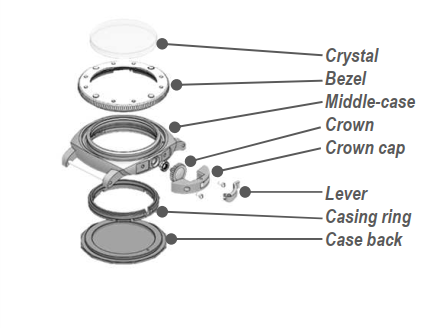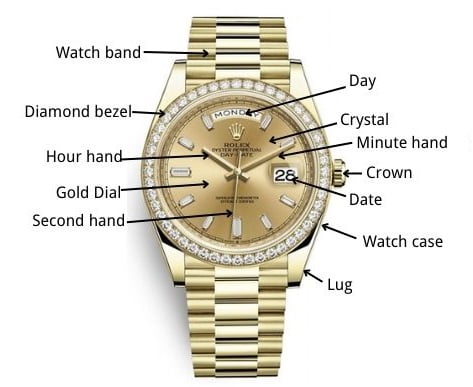Automatic Movement
An automatic movement is a mechanism within a watch that winds itself as the wearer moves their arm. It eliminates the need for manual winding by converting the motion of the arm into energy, which is then stored and used to keep the watch running.
Band
A watch band is a strap or bracelet that holds a watch onto the wearer’s wrist. It can be made from various materials such as leather, metal, or synthetic fabrics and is designed to be adjustable for a comfortable and secure fit.
Bracelet
The bracelet of a watch is the band that wraps around your wrist to hold the watch in place.
Bezel
The ring that surrounds the watch face. It’s often made from metal and can be either fixed or rotatable, depending on the watch design. On some watches, the bezel has markings for measuring elapsed time or for other functions like tracking a second time zone. It’s not just functional but also adds to the style and character of the watch.
Calendar
The calendar on a watch refers to a feature that displays the date, and often the day of the week. It’s usually seen through a small window on the watch’s dial.
Case
The case of a watch is the housing that encloses and protects the watch’s internal components.
Chronograpgh
A chronograph is a type of watch that combines the functions of a standard timekeeper with those of a stopwatch. It allows the wearer to measure elapsed time, often via additional sub-dials and push buttons on the side of the case. Chronographs can be used for timing events, such as races or cooking, and are a popular feature in both sports and aviation watches due to their precision and functionality.
Crown
The crown of a watch is a small knob usually located on the side of the watch case. It’s used to set the time and date on the watch. On mechanical watches, the crown is also used to wind the mainspring to power the watch. Some crowns are designed to screw down to enhance water resistance.
Crystal
Most high-end watches have "glass," which shields the dial and is typically made of acrylic, synthetic sapphire, or mineral glass. This material is extremely resistant to scratches. The most resilient and scratch-resistant kind of crystal is sapphire.
Deployment buckle or clasp
A mechanism for securing the watch strap or bracelet's two ends that folds over on itself. Unlike the conventional buckle and tang clasp, this style of fastener gives the watch a cleaner, more polished look and makes it easy for the wearer to put on and take off the watch.
Dial
This component, often known as the watch face, is what lends the timepiece its elegance, individuality, and charm.
Dual time/Second time zone bezel
An alternative time zone, distinct from the one indicated by the dial's hands, can be indicated by a revolving bezel.
Gasket
A rubber or plastic ring that keeps the watch's internal components sealed off from the outside world. Crown, crystal, and case back are usually used in conjunction with the watch.
Jewel
Elements used in watch movements as bearings are typically made from synthetic ruby or sapphire. These materials are employed to create nearly frictionless pivots or hubs at key points within the watch mechanism, significantly reducing mechanical friction.
Lugs
Extensions on both ends of the case that hold the spring pin, securing the strap or bracelet to the case.
Manual movement
A mechanical movement, referred to as a "hand-winding" movement, requires the mainspring to be manually wound each day using the crown.
Mechanical movement
A movement driven by a mainspring operating alongside a balance wheel. Mechanical movements can be classified as either automatic (self-winding), where the arm's motion during daily wear winds the watch, or manual (hand-winding), which requires the crown to be wound by hand regularly or daily.
Minute repeater
A unique feature found in some high-end mechanical watches and affordable quartz watches allows them to announce the time in hours, quarter-hours, and minutes with the push of a button. When the button is pressed, an audible chime sounds.
Perpetual calendar
A watch calendar feature that automatically adjusts for the varying number of days in each month and accounts for leap years.
Power reserve
A measure of how long a watch will operate after being fully wound or powered, without any additional input. Many modern mechanical watches have power reserves that last 40 hours.
Pusher
A button used to control the functions of a watch is known as a pusher. These are typically found on chronographs and watches with alarms.
PVD coating
Physical Vapor Deposition is an advanced vacuum-coating technique used to create a durable, wear-resistant finish on the external components of a watch, including the case and bracelet.
Quartz movement
A highly precise battery-powered electronic mechanism that uses the natural vibrations of a quartz crystal's frequency to control the functioning of the timepiece.
Screw down crown
A crown that screws securely into the case tube, enhancing the watch's water resistance.
Shock resistance
The capability of a watch to endure a drop from a height of three feet onto a wooden floor.
Sweep seconds hand
A sweep seconds hand is positioned at the center of the watch dial rather than on a sub-dial. It is exclusive to mechanical watches, moving smoothly in a manner imperceptible to the human eye. In contrast, on a quartz watch, the seconds hand moves visibly in small, distinct steps.
Tourbillon
A rare and advanced complication found exclusively in high-end mechanical watches compensates for gravitational effects. This feature mitigates minor performance variations in watch movement caused by the watch's orientation relative to gravity.
Winding stem
The internal component that transfers movement from the crown to the mechanisms controlling movement, winding, and hand adjustment.

